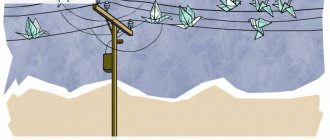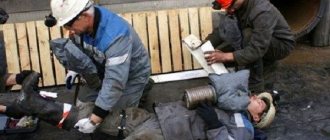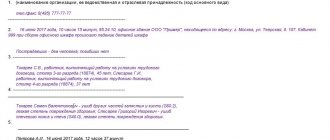General information
When an employee is injured, they are deprived of their livelihood and are faced with the need to pay for often expensive medical treatment.
And in the event of his death, the family is left without a breadwinner in a very difficult and vulnerable situation.
In order to provide employees and their families with the necessary level of social guarantees and to encourage the employer not to skimp on the safety of its employees, compulsory accident insurance was introduced by law.
And to ensure truly complete social protection of workers, voluntary insurance with increased payment limits is used.
The essence of insurance against accidents at work
Quite often, people have to work in conditions where physical harm to the body and deterioration of health are possible. All sorts of injuries occur, concussions, poisoning at work, and so on. There are very serious situations that result in loss of ability to work (temporary or even permanent) and the ability to earn money. In addition, treatment can be very expensive.
The introduction of compulsory insurance against accidents at work makes it possible to act based on the law. This not only obliges employers to take care of workplace safety, but also gives the employees themselves some social guarantees and financial support when accidents occur.
Working conditions at Russian enterprises are often harmful to health and even life-threatening. And then the risk of getting injured or acquiring occupational diseases increases for employees. Most often this concerns the metallurgical, nuclear, energy industries, chemical and glass factories, transport and technical, food and many other similar enterprises.
Moreover, an insured accident can occur not only at work, but also in seemingly absolutely safe workplaces. An accountant or IT specialist in the office may accidentally receive an electric shock.
The law stipulates the provision of social protection to employees in the event of accidents. This is Federal Law No. 125 “On compulsory social insurance against accidents at work and occupational diseases,” which stipulates the right of any officially employed person to be included in the insurance system. Moreover, the law obliges employers to insure citizens against any risk factors in the workplace and to equip these places in such a way that risks are minimized.
The concept of insurance here implies the creation of a legal monetary fund, formed from the funds of the employer and the employees themselves. In the event of an accident at work, insurance payments are made from this fund to the injured worker as compensation for damage caused to health. This money should cover the costs of comprehensive rehabilitation of a person (medical, professional and social). This type of insurance has been in effect in Russia since 2000.
Federal Law No. 125 (Article 5) requires insuring:
- officially employed employees, that is, working under an employment contract;
- persons serving a sentence and at the same time carrying out labor activities;
- persons working under a civil law contract or an author's contract, if these documents stipulate that the customer pays insurance premiums to the insurer.
The employer (individual or legal entity), who hires people and officially employs them, acts here as an insurer. And the Social Insurance Fund (SIF) is the insurer here. At the same time, tax services monitor all transactions carried out between the insurer and the policyholder.
System advantages
According to international experts, a properly organized social protection system can achieve the following advantages:
- involvement of employed citizens in minimizing production risks;
- receiving deductions from specialized structures whose tasks include prevention, health protection, calculations and payment of insurance compensation;
- guaranteeing the appointment of payments at established rates;
- reliability of financial structures involved in the formation of the material fund.
It is important to understand what role the state plays in organizing work. Its influence should be key, so that citizens receive effective protection, and their interests are guaranteed by state institutions.
Insurance premium calculation
How is the above fund formed? The law requires employers to transfer certain amounts to the Social Insurance Fund every month, the exact amount of which is not specified.
These amounts depend on what kind of insured event occurred at work and on the profession of the victim. For hazardous activities, the amount of insurance premiums for accidents at work will be higher.
In Order of the Ministry of Labor No. 851n dated December 30, 2021, all professions are divided into categories and 32 occupational risk classes are identified. The coefficients for calculating contributions for insured events at work range from 0.2% to 8.5%.
The lowest coefficient (0.2%) applies, for example, to people working in the printing industry or in the IT field. In the coal industry, settlement rates are the highest, that is, 8.5%.
The money is withheld from the remuneration that the insured employee receives for his work (for performing his direct duties at the workplace or for providing any services), in simple terms, from his salary. But the calculations do not affect:
- benefits paid to an employee by the state;
- all kinds of compensation: for payment of housing and communal services, for harm caused to health, for food, for the use of sports equipment, in the event of dismissal or for the remaining unused part of the vacation;
- redundancy benefits;
- compensation of costs for retraining and vocational training;
- reimbursement of travel expenses.
The insurer, when calculating the amount of compensation for an event that is insured at work, in addition to the mentioned coefficients, also assigns special discounts and allowances. What they will be depends on how the employer (enterprise or individual entrepreneur) carried out its activities over the past three years. This may be 40% or more of the applicable insurance rate.
Employer's liability
Responsibility for violation of the legislation regulating compulsory social insurance of workers against accidents is provided for by Federal Law No. 125-FZ of July 24, 1998:
| Article of Law 125-FZ | Basis of responsibility | Amount of fine |
| Art. 26.29 | Non-payment or incomplete payment of insurance premiums as a result of underestimation of the taxable base for calculating contributions, other incorrect calculation of insurance premiums or other illegal actions (inaction) | 20% of the amount of insurance premiums due (in case of deliberate understatement - 40%) |
| Part 1 art. 26.30 | Failure by the policyholder to submit a calculation of accrued and paid insurance premiums to the territorial body of the insurer at the place of his registration on time | 5% of the amount of insurance premiums accrued for payment for the last three months of the reporting (calculation) period, for each full or partial month from the date established for its submission, but not more than 30% of the specified amount and not less than 1000 rubles |
| Part 2 art. 26.30 | Failure of the policyholder to comply with the procedure for submitting calculations of accrued and paid premiums to the territorial body of the insurer in the form of electronic documents | 200 rubles |
| Art. 26.31 | Refusal to submit or failure to submit within the prescribed period by the policyholder to the territorial body of the insurer the documents (their copies, certified in the prescribed manner) necessary to monitor the correctness of calculation, timeliness and completeness of payment (transfer) of insurance premiums | 200 rubles for each document |
Situations eligible for insured event
To determine whether an insured event occurred at work, there is a law, namely, Federal Law No. 125 of June 24, 1998 “On compulsory social insurance against accidents at work and occupational diseases.” It states that an accident is an event that entails a violation of the employee’s health (injury, mutilation) in the process of work performed in accordance with the contract. Or if this is a case in which a person became disabled (temporarily or permanently), died, or was forced to transfer to another job.
Industrial accidents are considered to be those that occurred within the territory of the enterprise or on the way (to or from work) when the employee was in transport provided by the employer. Any harm to health caused during a business trip, along the way (to the place of business trip and back), or in the process of moving on work matters (on public transport, a company car, on foot) is also considered an accident under Article 227 of the Labor Code, paragraph 9 of Resolution No. 2 Plenum of the Armed Forces of the Russian Federation of March 10, 2011.
Determining an industrial incident as an insurance event implies the presence of the following factors:
- the employee’s health was harmed during the working day, on the way to (or back) work, or during a lunch break;
- the accident occurred while the employee was performing his assigned job duties, or he acted in the interests of his employer;
- the harm to health was caused precisely as a result of an accident at work.
If, as a result of the event, the employee is unable to work (temporarily or permanently), he is entitled to compensation payments. This is logical because a person cannot continue to work and provide for himself.
Article 227 of the Labor Code contains a list of cases that fall under the insurance category:
- injury at work - insured event;
- loss of limbs;
- burns of varying degrees;
- heat strokes;
- all kinds of poisoning;
- occupational diseases;
- frostbite and other circumstances in which human health is harmed.
It should be emphasized that compensation is due only if the employee was injured during the working day: at work, during a break, or while acting on behalf of his superiors. The right to receive insurance payments arises precisely at the moment when the incident occurs, not the next day or a few more days later.
The Labor Code (Part 6 of Article 229.2) also lists situations that do not fall under the category of insured events at work. This, for example, is an incident that occurred due to the fact that the employee was drunk at work.
A specific example: the company's chief marketer Semenova was sent by her superiors to a suburban holiday home for special training (the topic was team building). The organizers planned the event for the weekend, and one of the elements of the program was walking on a log fixed at a height of six meters from the ground. Semenova, having lost her balance, fell from a log, ended up on a safety net and in the process broke her arm (closed fracture).
To recognize an accident as an insurance company, an examination is required. It is carried out by the executive body of the Social Insurance Fund, having previously (upon request) received from the organization where Semenova works, the job description of the chief marketer, an order that the employee is sent to training, and a timesheet of the victim’s working hours (for the month when the incident occurred) and other documents. And here the task is to find out whether the event really took place on a weekend and whether the employee was obliged to participate in this event as part of her official duties.
The incident will not be regarded as an industrial insured event if during the inspection process it turns out that the employee’s job duties did not include participation in the above event and the harm to health is in no way directly related to the work of the chief marketer. Then the victim is not entitled to insurance payments, and the employer must bear the compensation costs.
Some lawyers will say that it makes no difference whether a full-fledged contract was concluded with the employee, or whether he was hired for seasonal (one-time) work, and at the same time he acted in the interests of the employer. In any case, the incident must be investigated with a view to paying compensation to the injured person. This is the wrong approach. An event can be considered as an insured event at work only if an employment relationship has been formalized with the employee who acted in the interests of the employer.
For example, this situation: citizen Kovalev, passing by a construction site, decided to ask if it was possible to get a job here. At this time, the workers were installing the beam and turned to Kovalev with a request for a little help. He agreed, but during the work the beam could not be held; it fell directly on Kovalev, and as a result his collarbone was broken. The construction and installation department, at whose site this incident occurred, did not hire Kovalev and did not enter into a labor agreement with him. That is, although the person acted in the interests of the organization, the incident that occurred is not an insured industrial accident.
Injuries, occupational diseases and occupational poisoning
An injury can result from a work accident.
There are several groups of injuries, depending on the severity of the injury or occupational disease:
- Various injuries leading to serious loss of health.
- Death as a result of injuries received.
- Damage to the body from temperature fluctuations - hypothermia or overheating.
- Burns.
- Irradiation, electric shock.
- Consequences of the explosion.
- Other cases.
The list of diseases acquired due to the performance of a labor function in a specific profession is recorded by order of the Ministry of Health and Social Development No. 417n dated April 27, 2012. It identifies the following categories of ailments:
- poisoning with chemical substances (one-time penetration of harmful substances into the human body, resulting in loss of ability to work);
- occupational exposure (manifestation of a protracted illness due to long-term exposure to unfavorable health factors at work);
- biological component;
- body stress.
Examples of industrial accidents
- Situation #1
At a polyethylene products factory, a foundry machine operator suffered a hand injury at his workplace in the workshop. This is definitely an accident at work, which is an insurance case, because it occurred on the territory of the plant, and the employee acted in accordance with the job description and was officially registered (with the signing of an employment contract).
- Situation No. 2
A courier who was traveling to one of the addresses for work was injured in a traffic accident. This is an industrial accident. Yes, it occurred outside the company’s territory, but trips to clients are the direct duty of the courier.
- Situation No. 3
The management of one company allowed drivers to park company cars at night closer to their place of residence (in guarded parking lots). This is what the driver Shevelev did, and in the morning, when he drove a company car to his place of work, he got into an accident and was injured.
- Situation No. 4
One employee went on a business trip by train. On the way, a train accident occurred, as a result of which a person received serious injuries. The incident qualifies as an insured industrial accident.
- Situation No. 5
Two truck drivers, Korolev and Borisov, worked on a cargo truck, which they drove alternately on trips. On one of the flights, when Borisov was driving and Korolev was resting at that time, an accident occurred. Both were hurt. This is an industrial accident, and it concerns both one and the other driver.
- Situation No. 6
Citizen Terekhov, working as a sailor on a long-distance vessel, set off on his next voyage to the open sea. One day he slipped on the deck (it was his free time, he was not on watch and was not busy with work), fell, broke his leg and became temporarily disabled. This incident is regarded as an insured industrial accident.
- Situation No. 7
Due to a sudden large fire at the N arms factory, an urgent evacuation of weapons was required. Management recruited plant employees to participate in this operation because the fire department could not have managed it on its own. Carpenter Vasilkov, saving weapons along with other workers, lingered in the burning building, resulting in serious burns. This is an industrial accident because Vasilkov acted on behalf of the employer and in his interests.
- Situation No. 8
The crane operator Ivanov was temporarily assigned by his superiors to the carpentry team, since the crane had been idle for some time. While on the eighth floor of a building under construction and working there with other carpenters, Ivanov stumbled and fell. The injuries received were incompatible with life, and the man died. He was not transferred to another job by official order, but there was a verbal instruction from an authorized representative of the employer, and Ivanov acted in the interests of the enterprise.
Industrial accident investigation
According to the Labor Code (Article 228), as soon as management receives a report of an accident at work, it is necessary to carefully study the situation. For this purpose, a commission is promptly formed, which is engaged in the investigation (Labor Code, Article 229). Members of the commission act in the manner set out in the Regulations on the Investigation and Recording of Occupational Diseases (hereinafter referred to as the Regulations on the Investigation). This document was approved by Decree of the Government of the Russian Federation No. 967 of December 15, 2000, and it is applicable to the extent that does not contradict the provisions of the Labor Code.
The basis for creating a commission is an order for the enterprise. The minimum composition prescribed in the Regulations on the Investigation (clause and in the Labor Code (Part 1, Article 229)) is three people. Members of the commission can be representatives of the employer and trade union organization, a specialist or authorized persons for labor protection. But the commission should not include employees responsible for compliance with labor safety rules at the facility where the incident took place.
The minimum composition prescribed in the Regulations on the Investigation (clause and in the Labor Code (Part 1, Article 229)) is three people. Members of the commission can be representatives of the employer and trade union organization, a specialist or authorized persons for labor protection. But the commission should not include employees responsible for compliance with labor safety rules at the facility where the incident took place.
The commission’s task is to conduct an investigation and determine whether the incident can be qualified as an insured industrial accident. Based on the results of the investigation, reports are drawn up: on the accident itself (using a unified form No. N-1, approved by Resolution of the Ministry of Labor of Russia No. 73 of October 24, 2002) and on the investigation carried out.
Two copies of the accident report are drawn up, both are signed by the employer, keeping one for himself. The second copy is given to the victim or his family members. It is also necessary to make a copy of this document and send it to the regional department of the FSS of Russia (initially the employer must be registered there).
The situation becomes more complicated if there are two or more victims, or if one of the participants (even one person) received serious injuries or died. In this case, firstly, form No. N-1 is filled out in the name of each victim. Secondly, an act (in triplicate) is drawn up on the investigation of the incident (group or serious accident or fatal accident), for which there is a special form No. 4, which was also adopted by Resolution No. 73 (dated October 24, 2002) of the Ministry labor of the Russian Federation.
The first copy is given to the injured employee (or relatives), the second remains with the employer, and the third is intended for the prosecutor's office (copies of all materials used in the investigation, copies of Form N-1 acts that were drawn up for each participant in the accident should be attached to it).
Again, copies of the act, Form No. 4, are made and sent to the State Labor Inspectorate and the regional branch of the Federal Social Insurance Fund of Russia, where, according to the Labor Code (Part 2, Article 230), the employer must be registered as an insurer.
Entitled insurance payments as a result of an accident
If the investigation showed that there was an insured accident at work, then Federal Law No. 125 (article) gives the victim the right to the following compensation:
gives the victim the right to the following compensation:
- 100% sick pay (in accordance with the average salary during the time the employee was unable to work);
- monthly insurance payments (or compensation issued as a lump sum);
- allocation of funds for medicines, payment for treatment, rehabilitation and recovery, as well as technical means, if necessary. This refers to crutches, prostheses, strollers, etc.;
- payment of medical personnel for additional special care;
- reimbursement of expenses for tickets if the victim’s health is seriously harmed and he needs sanatorium treatment;
- reimbursement of expenses associated with the victim’s stay in a sanatorium or resort (housing, food, medical procedures, etc.) if the person is forced to stay there after receiving injuries.
The possibility of receiving insurance payments by close relatives if an employee died as a result of an insured accident at work is separately stipulated. Then the children, parents of the victim or a non-working spouse can receive compensation. But this is the case if relatives provide for the children or brothers and sisters of the deceased who are not yet 14 years old.
Before all compensation payments are made, a medical and social examination will first be required. As for moral damage, the Social Insurance Fund does not compensate for it; this can be done by the employer (after the victim applies). But the employer may refuse to pay, in which case the problem will have to be resolved in court.
conclusions
Industrial accidents with serious consequences for health or life can have a significant impact on the company's budget. In addition to the costs of covering material damage, compensation must be paid. Compulsory and voluntary insurance helps reduce losses. Along with preventive measures, they help reduce the risks of injury and illness from work.
All production enterprises and their employees are subject to compulsory accident insurance. A voluntary agreement is not regulated by law, is concluded by the employer and has the following advantages:
- You can independently determine the terms of insurance in the contract (with compulsory insurance, they are established by law and cannot be changed).
- You can choose an insurance company.
- The list of risks can be increased or decreased.
Leave your likes and subscribe to always be aware of useful news. Share the article with friends and colleagues. In the chat you can get legal advice on insurance issues.
Read more about business risk insurance.









